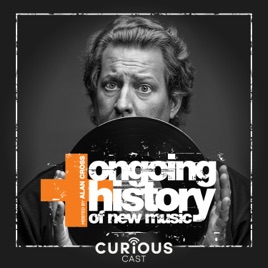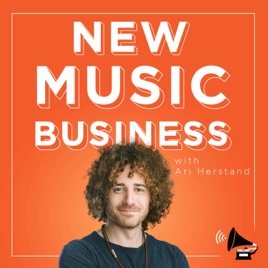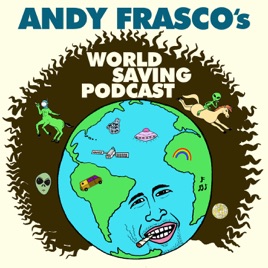
Advertise on podcast: Life of the Record
Rating
5 from
Country
This podcast has
36 episodes
Language
Publisher
Explicit
No
Date created
2019/11/11
Average duration
84 min.
Release period
40 days
Description
Classic albums, told by the people who made them.
Podcast episodes
Check latest episodes from Life of the Record podcast
The Making of OUT OF STEP by Minor Threat - featuring Ian MacKaye
2024/02/20
In celebration of the recently unearthed Out of Step Outtakes, we take a detailed look at the making of the original record. After Minor Threat formed in Washington D.C. in 1980, they began to find an audience in the American punk scene. Their first two seven-inch records contained songs written by Ian MacKaye, such as “Straight Edge” and “Out of Step,” which kickstarted the straight edge movement within punk. By 1982, guitarist Lyle Preslar had left for college and Minor Threat temporarily broke up. After speaking with H.R. of the Bad Brains, MacKaye was convinced of the impact the band was having and considered reforming. At that point, Preslar agreed to quit college and rejoin the band. Despite accusations of the band selling out by reforming, Minor Threat began playing shows in their hometown and embarked on a cross-country tour. Brian Baker decided to switch from bass to second guitar so they asked Steve Hansgen to join as the new bassist. In early 1983, they returned to Don Zientara’s Inner Ear Studio to begin recording as a five-piece. Out of Step was eventually released in the spring of 1983.
In this episode, Ian MacKaye describes this pivotal moment in the band’s history when they decided to reunite and change their sound by adding a fifth member. Though they faced backlash about reuniting from their hometown crowd, this fueled the next batch of songs they would write as a band. MacKaye discusses how most of his lyrics on this record reflect the gossip and backstabbing that was prevalent in their scene at the time. In addition, tension within the band was rising over MacKaye’s lyrics and their overall musical direction. The new version of the title track reflected their differences as Jeff Nelson convinced MacKaye to include a spoken word interlude that explained how the straight edge lyrics were personal to MacKaye and didn’t represent the band’s views. From Minor Threat’s first 12-inch to a joke song about selling out to recording vocals live for the first time to the benefits of an expensive strobe tuner to hearing the call of punk to self-define, we’ll hear the stories of how the record came together.
more
The Making of I SEE A DARKNESS by Bonnie "Prince" Billy - featuring Will Oldham
2024/01/19
For the 25th anniversary of the first Bonnie “Prince” Billy album, we take a detailed look at how it was made. Will Oldham grew up studying acting but decided to pursue music while he was attending Brown University. In 1992, he released his first single with Drag City under the name Palace Brothers. A series of albums followed under several variations of the Palace name, which reflected Oldham’s unique approach to treating the album, rather than the artist, as the primary entity. In 1998, he had an epiphany that he could inhabit a new character named Bonnie “Prince” Billy for his music moving forward and put his concerns about an artist identity to rest. He began living in his father’s farmhouse in Shelbyville, Kentucky along with his brother, Paul, who had been studying recording and set up a makeshift studio. In this isolated environment, Oldham worked on writing songs and had the freedom to record himself in a way that he never had before. Eventually, Oldham invited other musicians including Peter Townsend, Bob Arellano, Colin Gagon and David Pajo to flesh out the songs that would make up the I SEE A DARKNESS record.
In this episode, Will Oldham describes a newfound approach to making music at this time and how he viewed his former Palace work as his apprenticeship years. As Bonnie “Prince” Billy, he found that he could portray a larger than life character who had the power to sing songs across the emotional spectrum. The Bonnie character opened up his approach to songwriting as he began to incorporate some traditional elements like bridges and dramatic builds. From a growing confidence in his singing to a deteriorating relationship and the decision to form a sub label to a love of post-apocalyptic landscapes to adding humor as a release valve to taking inspiration from contemporaries like PJ Harvey to the unlikely events that led to Johnny Cash covering the title track, we’ll hear the stories of how the record came together.
more
The Making of SUPERFUZZ BIGMUFF by Mudhoney - featuring Mark Arm and Steve Turner
2023/12/13
For the 35th anniversary of Mudhoney’s first 12-inch record, SUPERFUZZ BIGMUFF, we take a detailed look at how it was made. After Mark Arm met Steve Turner at a show in Seattle, they became fast friends and began playing in multiple bands together. They started Green River with Jeff Ament and Alex Shumway and eventually added Stone Gossard on second guitar. Tensions over the musical direction of the band eventually caused Green River to dissolve with Ament and Gossard going on to form Mother Love Bone and Arm and Turner deciding to form Mudhoney. With Mudhoney, they had a vision for fuzz drenched guitars and blending 60s garage with punk rock. They eventually added Dan Peters on drums and Matt Lukin on bass and had their first practice on New Year’s Day in 1988. Bruce Pavitt of Sub Pop offered to pay for some studio time with Jack Endino so he could hear the material they were working on. From those sessions, they released the "Touch Me I’m Sick" single in the summer of 1988. At that point, they went back into the studio with Jack Endino to work on the songs that would become SUPERFUZZ BIGMUFF.
In this episode, Mark Arm describes his approach of “vocalizing” rather than singing, and how playing guitar with this band changed how he thought about song arrangements. Steve Turner talks about his discovery of vintage fuzz boxes and how they informed the Mudhoney sound at a time when fuzz pedals were out of fashion. From the early days of Sub Pop to rocking baby blue 60s guitars to Dan Peters’ unique drum patterns to Matt Lukin’s relief of playing simple songs to Sonic Youth knighting them as the next big thing to a pivotal moment in Seattle music, we’ll hear the stories of how the record came together.
more
The Making of CHUTES TOO NARROW by The Shins - featuring James Mercer
2023/11/08
For the 20th anniversary of The Shins’ second album, CHUTES TOO NARROW, we take a detailed look at how it was made. After getting their start in Albuquerque in the early nineties as a band called Flake, James Mercer, Neal Langford, Marty Crandall and Jesse Sandoval eventually morphed into The Shins. Mercer had first conceived of The Shins as an outlet for his quieter songs that weren’t working for Flake. Sandoval joined him initially and when Flake called it quits in the late nineties, Langford and Crandall also ended up joining The Shins. They caught the attention of Sub Pop, who signed them to a deal and released their debut album, OH, INVERTED WORLD in 2001. The album was a result of a year of recording at home with inexpensive gear that managed to reach a large audience. For their second album, Mercer had left Albuquerque and moved to Portland, Oregon, where he set up a basement studio with some better quality gear and recorded the majority of the record at home. Ultimately, the band finished the record with Phil Ek co-producing and mixing at Avast! Recording Co. in Seattle.
In this episode, James Mercer describes the pressure he was putting on himself to prove that The Shins weren’t just a fluke. With the goal of making a career in music, Mercer talks about this intense period when he was challenging himself as a songwriter to come up with interesting chord progressions and unique lyrics. Mercer also talks about the interpersonal relationships and shifting power dynamics in the band and how his close friendship with Neal Langford fell apart at this time. From wanting to make a stripped down and honest record to working with Phil Ek in a proper studio to the lineup change of Dave Hernandez replacing Langford to staying up all night to write a song at the very last minute to finding inspiration from a thrift store copy of Neil Young’s Harvest, we’ll hear the stories of how the record came together.
more
The Making of HOUDINI by Melvins - featuring Buzz Osborne
2023/10/04
For the 30th anniversary of the Melvins’ 1993 classic, HOUDINI, we take a detailed look at how the record was made. Buzz Osborne, Mike Dillard and Matt Lukin had formed the Melvins in 1983 when they were teenagers living in Montesano, Washington. Drummer Dale Crover ended up replacing Dillard early on and has remained with the band to this day. When Osborne and Crover decided to move to San Francisco, Lori Black took over on bass, and they began a series of releases with indie label, Boner Records. By the time, they got to their fifth album, they decided to sign to a major label as the Northwest music scene had exploded in popularity and had attracted the attention of the major labels. After they signed with Atlantic Records, they enlisted their old friend, Kurt Cobain, to produce the album.
In this episode, Buzz Osborne describes the difficult sessions that took place while making the record. Kurt Cobain was dealing with a heroin addiction at the time and would often not show up for sessions. Osborne talks about making the decision to fire Cobain right in the middle of the sessions. Ultimately, Cobain did have a hand in co-producing six tracks on the album and played guitar and drums on a couple songs. Osborne describes this period when the Melvins had already seen success on indie labels but decided to sign a contract with the major label powerhouse, Atlantic Records. Osborne describes his initial shock when Atlantic didn’t interfere with their creative process at all and let them make the record they wanted to make. From Osborne’s often nonsensical lyrical approach to the importance of dynamics in heavy music to a rotating cast of bass players to Dale Crover’s mastery of tempo and feel to combining classic rock with punk rock attitude to the Melvins belonging on a legendary label, we’ll hear the stories of how the record came together.
more
The Making of Cursive's DOMESTICA - featuring Tim Kasher
2023/09/12
In celebration of the deluxe edition of Cursive’s DOMESTICA, we take an in-depth look at how the record was made. Following the breakup of the Omaha band, Slowdown Virginia, Tim Kasher reunited with his former bandmates, Matt Maginn and Stephen Pedersen, to start a new project called Cursive. They brought in drummer Clint Schnase and released their first 7 inch on their friends’ label, Lumberjack Records, which later became Saddle Creek. Two full-length records followed, but when THE STORMS OF EARLY SUMMER was released in 1998, the band had already called it quits. Kasher had gotten married and moved to Portland, Oregon for a fresh start. As his marriage fell apart, he returned to Omaha and decided to reform Cursive. Pedersen had left for college at this point so Ted Stevens of Lullaby for the Working Class took over on guitar. Feeling like they had to make up for lost time, Cursive quickly put together an album’s worth of songs and entered the home studio of A.J. and Mike Mogis to record the album over nine days.
In this episode, Tim Kasher describes his vision of a concept album about a failed relationship that took inspiration from his recent divorce. With songs written from the perspective of both the male and female characters in the relationship, Kasher was writing in a fictional style but couldn’t help but include elements from his own life. When the album was released in 2000, Saddle Creek wrote a bio mentioning Kasher’s divorce that impacted the overall perception of the album, which Kasher still maintains is not a “divorce record.” From an attempt at being evenhanded in the storytelling to the Mogis brothers production skills to taking inspiration from the films, Eraserhead and Rosemary’s Baby, to a lifelong journey of understanding metal to fans asking Kasher for relationship advice, we’ll hear the stories around how the album came together.
more
The Making of GIVE UP by The Postal Service - featuring Ben Gibbard and Jimmy Tamborello
2023/07/18
For the 20th anniversary of The Postal Service record, GIVE UP, we take a detailed look at how it was made. After Jimmy Tamborello was looking for vocalists to collaborate with for a Dntel album he was working on, he connected with Ben Gibbard of Death Cab for Cutie. Gibbard agreed to provide vocals for a track that became, “(This Is) The Dream of Evan and Chan.” The two of them worked so well together that they decided to work on more material and form a new project. Tamborello’s friend, Tony Kiewel at Sub Pop heard about their collaboration and suggested they would be interested in releasing a full album. Tamborello got to work creating instrumentals at his home in Los Angeles and would mail rough mixes of the tracks on CD-Rs to Gibbard in Seattle. Gibbard would then come up with the melodies and lyrics, recording his vocals and other instruments to send back to Tamborello. Over the course of the year, they would keep collaborating through the mail, enlisting Jenny Lewis and Jen Wood to provide additional vocals. After the ten tracks were nearly complete, they met in Los Angeles to finish mixing the album. GIVE UP was eventually released in 2003.
In this episode, Gibbard describes how these Postal Service tracks that Tamborello would send were nice breaks in his writing schedule for Death Cab for Cutie, who were in the middle of writing TRANSATLANTICISM. Because their collaboration started so spontaneously, he describes how this approach opened up his writing and pushed him into new territory. Tamborello describes how he initially conceived of a more experimental project but quickly changed directions as the tracks became more pop oriented and Gibbard’s melodies were so infectious. With the limited technology of the early 2000s, he describes how the album was made almost entirely on a Kurzweil K2000 synthesizer and how he would manipulate sounds and sample classical records for added effect. As the concept of remote collaboration has taken off in recent years, GIVE UP remains a fascinating document of its time. From the unlikely marriage of indie rock and electronic music in the early 2000s to the slow process of mixing by mail to the spontaneous idea of asking Jenny Lewis to sing on the album, to the key influences of Bjork, Liz Phair, Conor Oberst and Stephin Merritt to the mysterious effortlessness of the whole project, we’ll hear the stories of how the record came together.
more
The Making of SURFER ROSA by Pixies - featuring Joey Santiago, David Lovering and Steve Albini
2023/06/06
For the 35th anniversary of Pixies’ landmark debut album, SURFER ROSA, we take a detailed look at how it was made. After Charles Thompson and Joey Santiago bonded as suitemates at the University of Massachusettes Amherst, they decided to form a band. By putting an ad in the Boston Phoenix for “a female vocalist into Hüsker Dü and Peter, Paul and Mary,” they connected with Kim Deal, who was the only one to answer their ad. Deal’s husband, John Murphy, introduced them to drummer David Lovering and the Pixies lineup was solidified. As they began playing around Boston, producer Gary Smith offered to record a demo for them at Fort Apache Studios. After Ivo Watts-Russell of the label 4AD heard the tapes, he signed them to a contract and they released some of the demo recordings as an EP called Come On Pilgrim. They turned their attention to recording a full-length album and Watts-Russell suggested a young engineer named Steve Albini. Albini traveled to Boston to meet the band and they began recording the next day at a studio called Q Division.
In this episode, guitarist Joey Santiago describes the early connection he shared with Charles Thompson and how SURFER ROSA solidified the band’s sound and was an honest depiction of who they were. David Lovering talks about his approach to simplifying his drumming and why SURFER ROSA remains his personal favorite Pixies album. Engineer, Steve Albini reflects on how this record marked the first time he worked with a band he didn’t know and how he set out to prove his value by making unique suggestions and how that impacted the finished product. From Charles and Kim’s contrasting vocal styles to their trademark loud quiet loud dynamics to the benefits of metal picks and recording in a tiled bathroom to the uniquely dark subject matter of the lyrics to the recorded sounds of the session underway, we’ll hear the stories of how the record came together.
more
The Making of VIOLENT FEMMES (Self-Titled) - featuring Gordon Gano, Brian Ritchie and Victor DeLorenzo
2023/04/25
For the 40th anniversary of Violent Femmes’ classic debut album, we take a detailed look at how it was made. After bassist Brian Ritchie and drummer Victor DeLorenzo first started playing around Milwaukee as a rhythm section, they met a teenage songwriter named Gordon Gano. Despite having limited experience and still just being in high school, Gano had an extraordinary set of good songs that he had already written. Violent Femmes began playing as a trio but weren’t able to get many gigs in town so they started playing acoustically on the street. One day they decided to play for a line of people outside the Oriental Theater who were there to see the Pretenders. James Honeyman-Scott was on a break from soundcheck and became interested in this band playing outside the theater. He convinced the rest of the Pretenders to listen and Chrissie Hynde ended up inviting the Femmes to open for them that night. Though the impromptu gig didn’t lead to other opportunities, it gave them a boost of confidence to continue doing what they were doing. Shake Records became interested in releasing an album so they booked studio time with producer Mark Van Hecke. The label deal fell through but they decided to keep the studio time with the help of a loan from DeLorenzo’s father. The recordings they made ended up on Slash Records’ radar and they eventually released the Violent Femmes debut album as is in 1983.
In this episode, Gordon Gano reflects on being a bored and lonely teenager who had a drive to write songs as a way to get out frustration. Brian Ritchie describes his unconventional approach to the acoustic bass guitar that helps give Violent Femmes their signature sound. Victor DeLorenzo offers his perspective on using brushes, a snare drum and his invention called the trancephone in order to have a simple setup that could be moved easily and played on the street. From being booed by thousands of Milwaukeans to punk music played acoustically to embracing the improvisation of Sun Ra to the first album as a mixtape that continues to get passed between generations, we’ll hear the stories of how the record came together.
more
The Making of LET GO by Nada Surf - featuring Matthew Caws
2023/03/14
For the 20th anniversary of Nada Surf’s third album, LET GO, we take a detailed look at how it was made. After Matthew Caws and Daniel Lorca formed the band in 1992, they eventually linked up with drummer, Ira Elliot. They spent several years grinding it out in their hometown of New York City where they worked multiple jobs and hustled to get their music heard. During a chance encounter with Ric Ocasek at a show at the Knitting Factory, Matthew Caws gave him a demo tape. A couple weeks later, Ocasek got back in touch with Matthew and offered to record them if they were able to sign to a label. Luckily, Elektra Records offered them a deal soon after and they went on to release their Ocasek-produced debut album, HIGH/LOW in 1996. Due to the unexpected success of the first single, “Popular,” Nada Surf found themselves under a lot of pressure for their follow-up album. THE PROXIMITY EFFECT was released in Europe in 1998 but Elektra got cold feet and decided not to release the album in the U.S. and ended up dropping the band. With no record contract, they found themselves back in New York, working odd jobs and calling in favors for help recording their third album, which ended up becoming LET GO.
In this episode, Matthew Caws joins us for an in-depth conversation about this pivotal moment in the band’s history when they went from being a major label success to suddenly being completely independent. Matthew describes how this period of his life was completely music-focused as he worked at a record store and spent all of his time going to shows and writing songs. The low pressure situation that they found themselves in inspired a more diverse group of songs and a more relaxed feel to their recordings than ever before. From sprinting home to remember song ideas to obsessively listening to a Sony Sports Walkman to writing a song in an Amsterdam bathroom to Chris Walla’s mixing skills to gratitude for recorded music, we’ll hear the stories of how the record came together.
more
The Making of JAMBOREE by Beat Happening - featuring Calvin Johnson, Heather Lewis, Bret Lunsford, Steve Fisk and Gary Lee Conner
2023/01/31
For the 35th anniversary of Beat Happening’s second album, JAMBOREE, we take a detailed look at how it was made. After meeting at the Evergreen State College in Olympia Washington, Calvin Johnson, Heather Lewis and Bret Lunsford formed Beat Happening and began releasing music under Calvin’s K label. In 1985, they released their self-titled debut album, which was later was picked up for UK distribution by Rough Trade Records. As the band was gaining interest beyond the Pacific Northwest, expectations were higher for their second album. Right before recording JAMBOREE, they linked up with their tourmates, Screaming Trees, in Ellensburg, Washington and recorded a joint EP in one night. They worked so well together that Beat Happening asked Screaming Trees’ Mark Lanegan and Gary Lee Conner to co-produce their next record, along with their friend, Steve Fisk.
In this episode, Calvin, Heather and Bret describe where the band was at when they were playing live more than ever before and developing relationships with other bands in the punk scene. Despite their limited technical abilities and lack of equipment, they describe the enthusiasm and optimism they felt about being in a band together at the time they made JAMBOREE. Producer Steve Fisk offers his unique perspective on first meeting a teenage Calvin and going on to record multiple Beat Happening albums. Co-producer Gary Lee Conner describes the unlikely musical pairing of Screaming Trees and Beat Happening but how they were kindred spirits, being outsiders with a shared DIY philosophy. From one borrowed distortion pedal to Screaming Trees as a cheering section to not understanding the concept of singing on key to the bravery of a cappella performances to the difficulty of having only one clave, we’ll hear the stories of how the record came together.
more
The Making of SONG CYCLE - featuring Van Dyke Parks and Richard Henderson
2022/12/13
For the 55th anniversary of Van Dyke Parks’ debut solo album, SONG CYCLE, we take a detailed look at how it was made. After being born in the South, Parks grew up studying music and working as a child actor before settling in Los Angeles, California in the early 1960s. While playing guitar in different folk groups around town, he got his first job as an arranger on “The Bare Necessities” for Disney’s The Jungle Book. Parks began working as a session musician for Producer Terry Melcher, who later introduced him to Brian Wilson of the Beach Boys. Parks was hired as a lyricist for the Beach Boys SMILE project, but ultimately left due to the rapidly deteriorating recording sessions and resistance from other members of the Beach Boys about the new lyrical direction. Producer Lenny Waronker then signed Parks to a contract with Warner Bros. as they recorded the first single “Donovan’s Colours” before beginning work on a full-length album.
In this episode, Van Dyke Parks reflects on his fascination with the developing technology of recorded music in the late 1960s. He also describes his fragile emotional state after the death of his brother and how traumatic personal and political events of the era informed his songwriting. Richard Henderson, author of the 33 1/3 book Song Cycle, offers his perspective on Parks’ working methods at the time and how he was able to convince Warner Bros. to bankroll this massively expensive project. From the gold rush of Laurel Canyon to confirming his fellow struggling artists in song to the recording studio as an instrument to the orchestra as pop art to an insulting marketing campaign in the wake of SONG CYCLE’s release, we’ll hear the stories of how the record came together.
Intro/outro music by ings from her song, "Love You." Episode art by Scott Arnold.
more
Podcast reviews
Read Life of the Record podcast reviews
JStGerm12345
2024/02/20
DO UNREST - IMPERIAL!
Melvins was good. Beat Happening was great. DO UNREST!!
Woohoo98222468227
2024/01/04
five stars
big star & replacements episodes are killer!!!
ClarkWashington
2023/12/15
Best music podcast
This is the reason I got into listening to podcasts! Paying attention to “lesser know” but amazing and inspiring indie rock bands!
Banjothebandit
2023/12/13
Soooo goood
The Wye Oak episode is soooo good! Thank y’all for making this
Burleith20007
2023/06/04
Great music lessons
This is amazing musical oral history — I’ve listened to the Mission of Burma and Violent Femmes episodes. They are both really well done, commentary a...
more
Andysweetpotato
2023/05/07
Big Star
I loved the episode on Big Star! Violent Femmes was also excellent.
PyramidKid
2023/04/25
Nothing but the oral histories of the creators
I really appreciate that the person making this excellent podcast gets out of the way and lets the work, and the artists, speak for themselves. They a...
more
el-mongolo-rey
2023/04/25
Great, great stuff
I love this insightful and in-depth approach to how music is created. It is indispensible!
Big Gravy
2023/04/06
Indispensable oral histories
You know how when an album’s great you can’t pick your favorite song? You keep listening and you keep changing your mind. Same with Life of the Record...
more
rv aka df
2022/12/20
Essential
I hope the creator(s) of this podcast know(s) how important and appreciated their work is.
Podcast sponsorship advertising
Start advertising on Life of the Record & sponsor relevant audience podcasts
You may also like these music interviews Podcasts

4.8
2436
50
Aria Code
WQXR & The Metropolitan Opera

4.3
121
2006
On Air With Ryan Seacrest
iHeartPodcasts

4.9
487
424
Ongoing History of New Music
Curiouscast

4.9
174
145
The New Music Business with Ari Herstand
Ari's Take

4.9
522
280
Andy Frasco's World Saving Podcast
Andy Frasco

4.8
472
34
Metronom - مترونوم
metronom

4.9
613
113
Agushto Papa Podcast
Agushto LLC

3.9
65
23
Rolling Stone's 500 Greatest Albums
Rolling Stone | Amazon Music

4.9
2219
727
Dean Delray's LET THERE BE TALK
Cactus Radio Network

4.8
214
23
No F'n Regrets with Robb Flynn
GaS Digital Network



